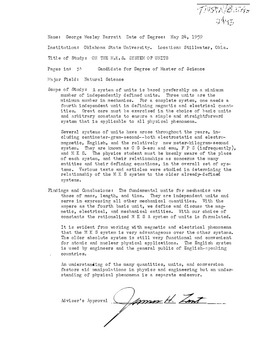| dc.contributor.advisor | Durbin, Frank M. | |
| dc.contributor.author | Barratt, George Wesley | |
| dc.date.accessioned | 2016-03-03T20:09:07Z | |
| dc.date.available | 2016-03-03T20:09:07Z | |
| dc.date.issued | 1959-05 | |
| dc.identifier.uri | https://hdl.handle.net/11244/32165 | |
| dc.description.abstract | Scope of Study: A system of units is based preferably on a minimum number of independently defined units. Three units are the minimum number in mechanics. For a complete system, one needs a fourth independent unit in defining magnetic and electrical quantities. Great care must be exercised in the choice of basic units and arbitrary constants to ensure a simple and straightforward system that is applicable to all physical phenomena. | |
| dc.description.abstract | Several systems of units have arose throughout the years, including centimeter-gram-second--both electrostatic and electromagnetic, English, and the relatively new meter-kilogram-second system. They are known as CG S-esu and emu, FPS (infrequently), and MKS. The physics student must be keenly aware of the place of each system, and their relationships as concerns the many entities and their defining equations, in the overall set of systems. Various texts and articles were studied in determining the relationship of the MKS system to the older already-defined systems. | |
| dc.description.abstract | Findings and Conclusions: The fundamental units for mechanics are those of mass, length, and time. They are independent units and serve in expressing all other mechanical quantities. With the ampere as the fourth basic unit, we define and discuss the magnetic, electrical, and mechanical entities. With our choice of constants the rationalized M K S A system of units is formulated. | |
| dc.description.abstract | It is evident from working with magnetic and electrical phenomena that the M K S system is very advantageous over the other systems. The older absolute system is still very functional and convenient for atomic and nuclear physical applications. The English system is used by engineers and the general public of English speaking countries. | |
| dc.description.abstract | An understanding of the many quantities, units, and conversion factors aid manipulations in physics and engineering but an understanding of physical phenomena is a separate endeavor. | |
| dc.format | application/pdf | |
| dc.language | en_US | |
| dc.rights | Copyright is held by the author who has granted the Oklahoma State University Library the non-exclusive right to share this material in its institutional repository. Contact Digital Library Services at lib-dls@okstate.edu or 405-744-9161 for the permission policy on the use, reproduction or distribution of this material. | |
| dc.title | On the M.K.S. system of units | |
| dc.contributor.committeeMember | Zant, James H. | |
| osu.filename | Thesis-1959R-B269o.pdf | |
| osu.accesstype | Open Access | |
| dc.type.genre | Master's Report | |
| dc.type.material | Text | |
| thesis.degree.discipline | Natural Science | |
| thesis.degree.grantor | Oklahoma State University | |
